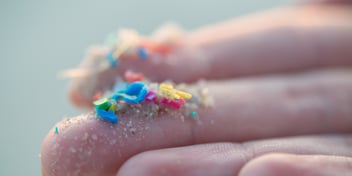Are microplastics a mega problem for water utilities?
Drinking water has been identified as the largest single source of microplastic ingestion in a new study from researchers at the University of Newcastle.
The study was commissioned by the World Wide Fund for Nature (WWF) and carried out by microplastics experts Dr Thava Palanisami and Research Assistant Kala Senathirajah.
They collated findings from 50 international research papers to determine the level of microplastics in different types of consumables, including drinking water (both tap and bottled), shellfish, salt and beer.
From this, they found people around the world are ingesting as much as 5 g – or a credit card’s worth – of microplastics a week.
This rate is likely to be lower in Australia due to lower seafood consumption rates and less plastic in the environment.
“Because there is a limited amount of information available, we had to make some assumptions, infill data and extrapolate data to come up with that figure,” Senathirajah said.
"We have taken a very conservative approach to come up with a single global ingestion rate.”
Plastic (not so) fantastic
To assess the concentration of microplastics in drinking water, the researchers took an average of both bottled and tap. Senathirajah said this was to account for the fact that certain countries are more reliant on bottled water sources, and others might be drinking untreated water.
While there wasn’t enough information to get into region-specific details, the study did show there were a lot more microplastics in bottled water than tap.
Bob Symons, National Technical Manager at laboratory testing company Eurofins, said this is primarily because of how bottled water is packaged.
“Most of the contaminants seem to come from the caps or the polyethylene terephthalate [PET] bottles, not from the actual water itself,” Symons said.
Symons, who lent his expertise to the ‘Microplastics – Megaproblem?’ workshop at Ozwater’19, said about 400 Eurofins labs across the world recently took part in a study of microplastics in tap water.
He said the local samples, which were taken from locations including Melbourne, Sydney, Brisbane, Perth, Wollongong, Newcastle, Darwin and Adelaide, showed there was no cause for concern.
“We sent about 20 samples of drinking water to one of our labs in Norway for analysis,” Symons said.
“The testing showed they were all negative or below the limit of reporting.”
A different stream of enquiry
Along with ingesting microplastics through consumables, Symons said biosolids are another possible way for the contaminants to make their way into our systems.
“Reports say that between 95% and 99% of the microplastics that go through the wastewater treatment system are caught up in biosolids,” he said.
“There’s only a small fraction being discharged into the environment after the water has been treated, so the concern is the microplastics in the biosolids.”
Although biosolids are generally used in forestry and for other non-food production areas, Symons said it’s possible that biosolids containing microplastics could be used on agricultural land and eventually end up in the food chain.
This is an emerging area of interest for Australian water utilities. A number of organisations, including Queensland Urban Utilities, Sydney Water and Water Corporation have signed up to a research project with Eurofins and Professor Fred Leusch from Griffith University looking at microplastics in biosolids.
“We hope to get some insight into the levels of microplastics that are in Australian wastewater treatment plants,” Symons said.
Standard approaches
Both Senathirajah and Symons said one of the biggest challenges in tackling the microplastics problem is a lack of standardisation.
“There’s a dearth of information about microplastics,” Symons said.
“I come from an analytical background, so to me, one of the issues is that there are no standard methods for ‘doing’ microplastics.”
The technology is also still evolving. For example, microplastics are normally assessed from 1 micron up to 5 mm, but researchers only used to be able to detect particles as small as 300 microns.
“Sampling is a big issue. If you’re not collecting samples below a certain size, your testing isn’t really representative,” Symons said.
“Also, toxicologists seem to think that it’s the smaller pieces that are a major concern from a human point of view – they’re the ones you need really good methods around.”
Senathirajah echoed this, and said there needs to be globally accepted methods for testing and assessing microplastics in order to properly understand the issue.
“Even things like reporting units, if this could be agreed upon it would make comparing data from various sources more straightforward,” she said.
Worldwide problem
The WWF study isn’t the first to draw attention to the growing problem of microplastics. There has been an explosion of research on the topic in recent years, and more is due to be released, including a report from the World Health Organisation later this year.
WWF International Director General Marco Lambertini said the study shows plastic pollution is a global problem that needs to be addressed urgently.
“These findings must serve as a wake-up call to governments,” Lambertini said.
“Not only are plastics polluting our oceans and waterways and killing marine life, they’re in all of us – we can’t escape consuming plastics.”
WWF is calling for a legally binding treaty on marine plastics pollution that would establish national targets and transparent reporting mechanisms. It would also provide financial and technical support for low-income countries to improve their waste management practices.
Although more information is needed about the impact of microplastics on humans, Senathirajah said it will become easier to create regulations as the science evolves.
“At the moment there aren’t really any regulations in relation to microplastics,” she said.
“We don’t necessarily have enough scientific evidence to determine what the regulation needs to be, but we do need to take action.
“Microplastics don’t know boundaries, they can travel in water and air, so it needs to be a global effort.”
Related podcast:
https://omny.fm/shows/australianwater/wilson-xu-on-detoxing-our-waterways

